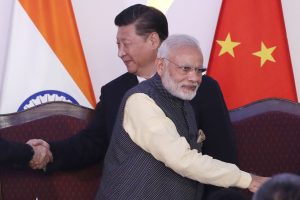In a major development, India and China announced on Thursday that their armies have started to disengage from Patrolling Point 15 (PP-15) in the Gogra-Hotsprings area along the Line of Actual Control (LAC) in eastern Ladakh.
“On September 08, 2022, according to the consensus reached in the 16th round of India China Corps Commander Level Meeting, the Indian and Chinese troops in the area of Gogra-Hotsprings (PP-15) have begun to disengage in a coordinated and planned way, which is conducive to the peace and tranquility in the border areas,” the Indian Army and China’s People’s Liberation Army said in a joint statement.
The disengagement process will be completed by Monday, September 12. “It has been agreed that all temporary structures and other allied infrastructure created in the area by both sides will be dismantled and mutually verified,” India’s Ministry of External Affairs told the media today, adding that “landforms in the area will be restored to the pre-standoff period by both sides.”
A disengagement pact on Gogra-Hotsprings was perceived as “low hanging fruit;” agreement on the pullback of troops here was seen to be within reach as there were only 80-100 troops deployed here by both sides. There were expectations that an agreement on this would be reached at the 12th round of talks. It did not happen. In fact, an agreement remained elusive till the 16th round of talks between military commanders of the two sides which was held on July 17 at the Chushul-Moldo border meeting point.
The agreement on disengagement from Gogra-Hotsprings is important as it comes after a year-long long impasse in the talks process.
Tensions between India and China began escalating in April-May 2020 when Chinese troops began crossing into the Indian side of the LAC at several points. The tense situation erupted in violent hand-to hand combat between Indian and Chinese soldiers in June at the Galwan Valley.
Talks between senior military commanders of the Indian Army and the PLA began in August 2020 and these, pushed along by talks between ministers of the two sides, resulted in the disengagement of troops from “friction points” at Galwan Valley in July 2020, the north and south banks of Pangong Tso in February 2021, and Gogra Post (PP-17A) in August 2021.
However, the talks ran into trouble. Indeed, the 13th round in October 2021 ended in an acrimonious verbal exchange. Subsequent rounds of talks saw little progress on the ground.
While some have interpreted the disengagement from Gogra-Hotsprings as a Chinese “retreat,” others are more skeptical.
As at other friction points where disengagement of troops has happened, here too the two sides are likely to create a “buffer zone” or a “no-patrolling” zone. It has been reported that these buffer zones are eating deep into Indian-controlled territory.
“Will disengagement at India’s Patrolling Point-15 be akin to the Galwan and Pangong disengagement—China first encroaches on Indian area, then foists a buffer zone formalizing a changed status quo?” Indian strategic expert Brahma Chellaney tweeted.
Lt. Gen. Rakesh Sharma, a former General Officer Commanding the “Fire and Fury Corps” in Ladakh, has raised the pertinent question of who will control the pass at PP-15 after the disengagement of troops from the area. “Point is who controls the Pass at PP15! And how much distance for PLA and IA [Indian Army] from PP15,” he tweeted.
The Indian government has shared little information of what it is conceding to get the Chinese to disengage its troops from friction points.
With the disengagement at PP-15, troops have pulled back from one more friction point. However, disengagement from Depsang and Demchok remains. Apparently, the Chinese are unwilling to even discuss this.
The announcement about Gogra-Hot Springs has come a week ahead of the annual summit of the Shanghai Cooperation Organization (SCO) in Samarkand, Uzbekistan. India’s Prime Minister Narendra Modi and Chinese President Xi Jinping will be attending the summit.
Speculation is rife over the possibility of a Modi-Xi meeting on the sidelines of the summit. While no announcement has been made in this regard so far, the breakthrough relating to the disengagement of troops at PP-15 eases the way for such a meeting.
However, a Modi-Xi summit should not be interpreted as a sign of improving relations.
In April 2018, Modi and Xi met for their first “informal summit” in Wuhan, China. The second “informal summit” was in Mamallapuram, India in October 2019. Effusive rhetoric was exchanged at the two summits. A month later the two leaders met at Brazilia on the sidelines of the BRICS summit.
After the 2019 BRICS summit meeting, Xi said: “I am willing to maintain close communication with you to jointly steer the direction of China-India relations, increase political mutual trust, properly manage differences and expand practical cooperation so as to guide better and more stable development of bilateral relations.” He said he was looking forward to meeting Modi in China for the third informal summit.
It did seem then that bilateral relations were looking up.
However, a few months later in April 2020, the PLA sent its soldiers into the Indian side of the LAC. Relations have been deeply troubled since then.
While India has reiterated that resolving the standoff at the border is necessary for the normalization of relations with China, the latter has called on India to put aside the border dispute and normalize relations. Who will blink? We may know in a week if a Modi-Xi summit happens.

































